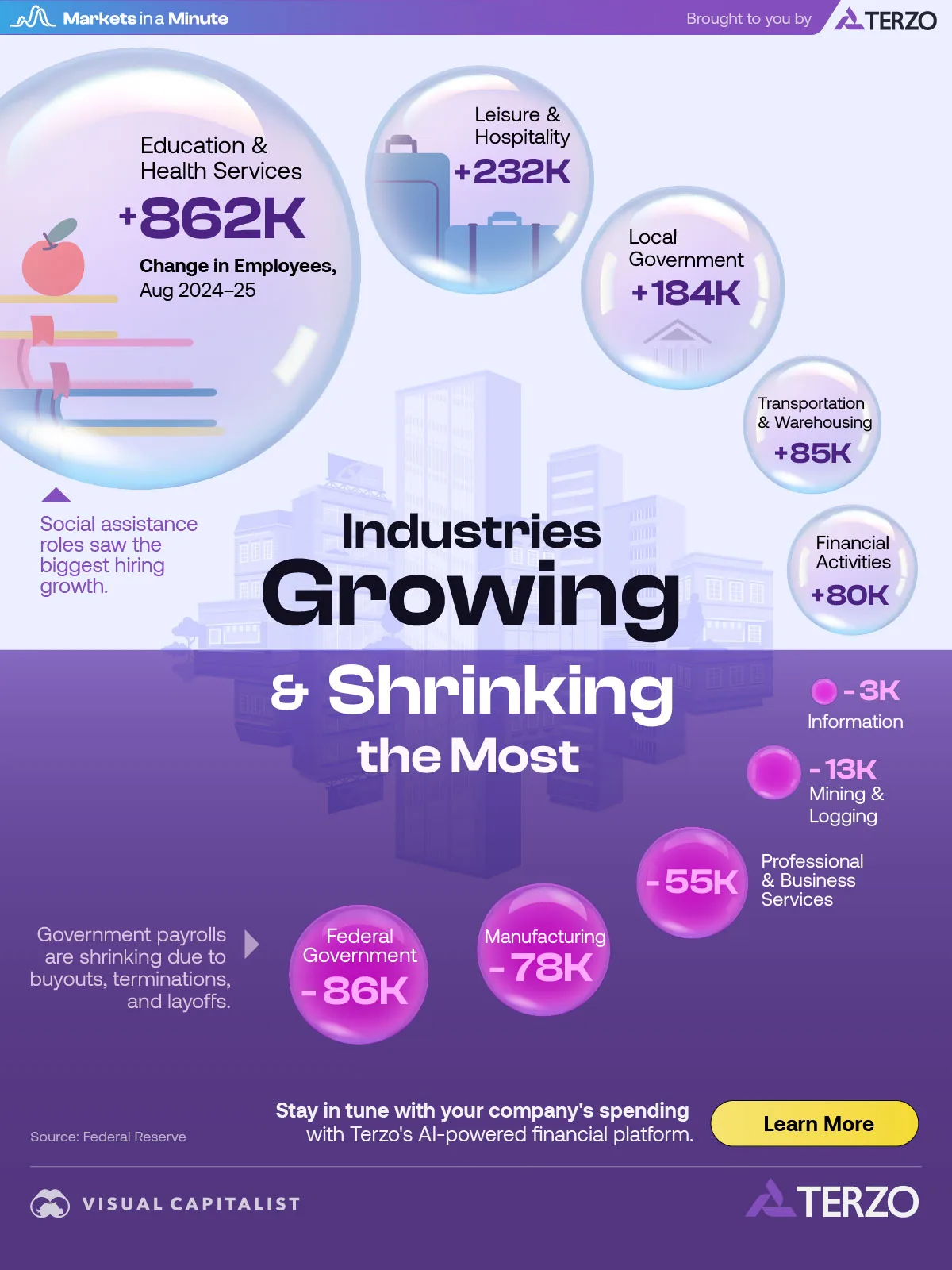
Published
36 minutes ago
on
October 13, 2025
| 8 views
-->
By
Jenna Ross
Graphics & Design
- Lebon Siu
- Jennifer West
The following content is sponsored by Terzo
Industries Hiring and Firing the Most Employees
Key Takeaways
- The Education & Health Services industry has been hiring the most employees over the last year.
- In contrast, the federal government has seen the biggest reduction in the number of employees.
Hiring trends can serve as an early signal of where the U.S. economy is heading next. By looking at which industries are adding—or cutting—the most jobs, we get a clearer picture of where business confidence is rising, and where it’s slipping.
This graphic was created in partnership with Terzo for our Markets in a Minute series, which features quick economic insights for executives. It zooms out to see the longer-term change in employees across industries from August 2024 to August 2025.
We’re Hiring: Industries Adding the Most Employees
The industry hiring by far the most employees was education and health services. Both areas require significant human interaction, meaning they could be safest from AI replacement. On top of this, healthcare continues to see a boom from the aging population.
Within the industry, social assistance saw the most growth which includes roles like child care workers, home care aides, and social workers.
| Industry | Change in Number of Employees, Aug 2024–Aug 2025 |
|---|---|
| Education and Health Services | +862,000 |
| Leisure and Hospitality | +232,000 |
| Local Government | +184,000 |
| Transportation and Warehousing | +84,700 |
| Financial Activities | +80,000 |
Source: U.S. Bureau of Labor Statistics via Federal Reserve.
Leisure and hospitality saw the second-strongest hiring push, driving primarily by employment increases within food services and drinking places.
Industries With the Biggest Drops in Employees
At the other end of the scale, federal government jobs have declined the most. In an effort to increase efficiency and reduce waste, the government has undertaken layoffs, buyouts, and terminations.
| Industry | Change in Number of Employees, Aug 2024–Aug 2025 |
|---|---|
| Federal Government | -86,000 |
| Manufacturing | -78,000 |
| Professional and Business Services | -55,000 |
| Mining and Logging | -13,000 |
| Information | -3,000 |
Source: U.S. Bureau of Labor Statistics via Federal Reserve.
Manufacturing jobs saw the second-largest decline, continuing a trend seen over the last several decades. Investments in automation have led to less hiring in manufacturing as companies achieve more productivity per worker.
More recently, economists believe uncertainty related to tariffs has discouraged companies from increasing their workforce as costs rise.
Recent Job Shifts
In the absence of the September jobs report from the Bureau of Labor Statistics (BLS), people are turning to private reports for an estimate on the labor market. Many estimates point to cooling conditions.
Carlyle, a global investment firm, estimates that employers added 17,000 jobs in September. As a point of comparison, the August report from the BLS showed gains of 22,000.

Stay in tune with your company’s spending, revenue, and risk with Terzo’s AI-powered financial platform.
More from Terzo
-

Markets2 weeks ago
The $150T Global Debt Market
Global debt continues to climb, reaching $150T in Q1 2025. Which countries carry the heaviest burdens?
-
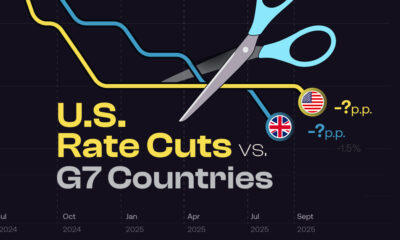
Money4 weeks ago
NEW: Fed Rate Cuts vs. Other G7 Countries
How do Fed rate cuts in the U.S. compare with the interest rate changes in other G7 countries, and what does it mean for business?
-
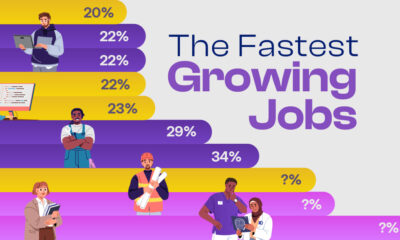
Jobs1 month ago
Ranked: The Fastest Growing Jobs (2024-2034)
Explore the fastest growing jobs by projected growth rate, plus salary insights, in a rapidly changing job market.
-

Investor Education2 months ago
The $127 Trillion Global Stock Market in One Giant Chart
This graphic pieces together the $127T global stock market to reveal which countries and regions dominate—and how much equity they control.
-

Personal Finance2 months ago
Late to the Ladder: The Rise in First-Time Home Buyers’ Age
The median age of first-time home buyers has reached a historic high. See just how long it’s taking people to get on the property ladder.
-

Markets2 months ago
Unpacking Real Estate Ownership by Generation (1991 vs. 2025)
The Silent Generation’s share of real estate has dropped dramatically as people age, but how have Baby Boomers, Gen X, and Millennials fared?
-

Business3 months ago
America’s Economic Engines: The Biggest Industry in Every State
Real estate is the biggest industry by GDP in 26 states. Find out why it dominates—and what fuels the rest of the country.
-
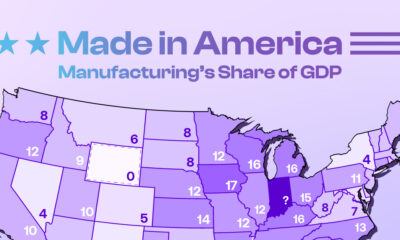
Maps3 months ago
Mapped: Manufacturing as a Share of GDP, by U.S. State
Tariffs are rising to boost American-made goods. Which states gain the most—and least—from manufacturing today?
-

Technology3 months ago
Profit Powerhouses: Ranking The Top 10 U.S. Companies by Net Income
Collectively, the ten most profitable U.S. companies have a net income of $684 billion—more than the entire GDP of Belgium.
-

Money4 months ago
Millionaire Hubs: Mapping the World’s Wealthiest Cities
New York City has the highest millionaire population globally. Which other cities attract the world’s wealthiest?
-
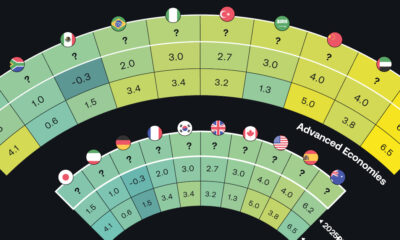
Economy4 months ago
Tomorrow’s Growth: GDP Projections in Key Economies
The global economy is expected to have slighter slower growth going forward. Which countries are on track to have the biggest GDP increases?
-
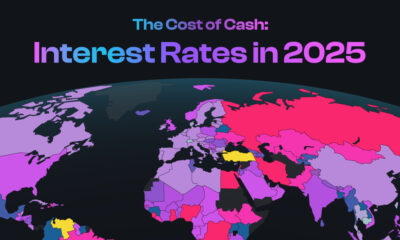
Money5 months ago
Mapped: Interest Rates by Country in 2025
The U.S. has kept their target rate the same at 4.25-4.50%. What do interest rates look like in other countries amid economic uncertainty?
-

Markets6 months ago
U.S. Housing Prices: Which States Are Booming or Cooling?
The national housing market saw a 4.5% rise in house prices. This graphic reveals which states had high price growth, and which didn’t.
-
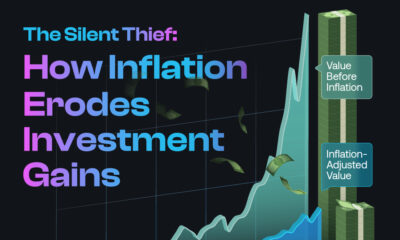
Investor Education7 months ago
The Silent Thief: How Inflation Erodes Investment Gains
If you held a $1,000 investment from 1975-2024, this chart shows how the inflation rate can drastically reduce the value of your money.
-

Politics7 months ago
Trade Tug of War: America’s Largest Trade Deficits
Trump cites trade deficits—the U.S. importing more than it exports—as one reason for tariffs. Which countries represent the largest deficits?
Subscribe
Please enable JavaScript in your browser to complete this form.Join 375,000+ email subscribers: *Sign Up